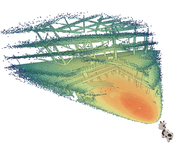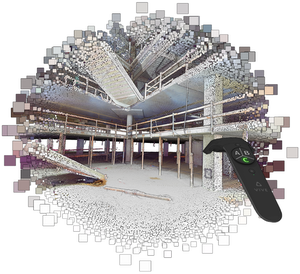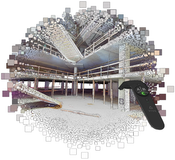Information
- Publication Type: Conference Paper
- Workgroup(s)/Project(s):
- Date: March 2019
- Publisher: IEEE
- Location: Osaka, Japan
- Lecturer: Markus Schütz
- Event: IEEE VR 2019, the 26th IEEE Conference on Virtual Reality and 3D User Interfaces
- DOI: 10.1109/VR.2019.8798284
- Call for Papers: Call for Paper
- Booktitle: 2019 IEEE Conference on Virtual Reality and 3D User Interfaces
- Conference date: 23. March 2019 – 27. March 2019
- Pages: 103 – 110
- Keywords: point clouds, virtual reality, VR
Abstract
Real-time rendering of large point clouds requires acceleration structures that reduce the number of points drawn on screen. State-of-the art algorithms group and render points in hierarchically organized chunks with varying extent and density, which results in sudden changes of density from one level of detail to another, as well as noticeable popping artifacts when additional chunks are blended in or out. These popping artifacts are especially noticeable at lower levels of detail, and consequently in virtual reality, where high performance requirements impose a reduction in detail.We propose a continuous level-of-detail method that exhibits gradual rather than sudden changes in density. Our method continuously recreates a down-sampled vertex buffer from the full point cloud, based on camera orientation, position, and distance to the camera, in a point-wise rather than chunk-wise fashion and at speeds up to 17 million points per millisecond. As a result, additional details are blended in or out in a less noticeable and significantly less irritating manner as compared to the state of the art. The improved acceptance of our method was successfully evaluated in a user study.
Additional Files and Images
Additional images and videos
 birds_eye:
continuous LOD subsample selected for the users current viewpoint
birds_eye:
continuous LOD subsample selected for the users current viewpoint
 distribution:
More uniform distribution of points in screen space, compared to staircase artifacts from discrete LOD methods.
distribution:
More uniform distribution of points in screen space, compared to staircase artifacts from discrete LOD methods.
Additional files
Weblinks
BibTeX
@inproceedings{schuetz-2019-CLOD,
title = "Real-Time Continuous Level of Detail Rendering of Point
Clouds",
author = "Markus Sch\"{u}tz and Katharina Kr\"{o}sl and Michael Wimmer",
year = "2019",
abstract = "Real-time rendering of large point clouds requires
acceleration structures that reduce the number of points
drawn on screen. State-of-the art algorithms group and
render points in hierarchically organized chunks with
varying extent and density, which results in sudden changes
of density from one level of detail to another, as well as
noticeable popping artifacts when additional chunks are
blended in or out. These popping artifacts are especially
noticeable at lower levels of detail, and consequently in
virtual reality, where high performance requirements impose
a reduction in detail. We propose a continuous
level-of-detail method that exhibits gradual rather than
sudden changes in density. Our method continuously recreates
a down-sampled vertex buffer from the full point cloud,
based on camera orientation, position, and distance to the
camera, in a point-wise rather than chunk-wise fashion and
at speeds up to 17 million points per millisecond. As a
result, additional details are blended in or out in a less
noticeable and significantly less irritating manner as
compared to the state of the art. The improved acceptance of
our method was successfully evaluated in a user study.",
month = mar,
publisher = "IEEE",
location = "Osaka, Japan",
event = "IEEE VR 2019, the 26th IEEE Conference on Virtual Reality
and 3D User Interfaces",
doi = "10.1109/VR.2019.8798284",
booktitle = "2019 IEEE Conference on Virtual Reality and 3D User
Interfaces",
pages = "103--110",
keywords = "point clouds, virtual reality, VR",
URL = "https://www.cg.tuwien.ac.at/research/publications/2019/schuetz-2019-CLOD/",
}



